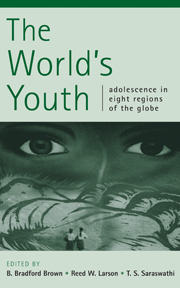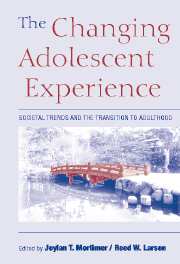22 results
5 - Youth Development Programs
- from Part I - The Self and Its Impact
-
-
- Book:
- The Cambridge Handbook of Motivation and Learning
- Published online:
- 15 February 2019
- Print publication:
- 14 February 2019, pp 111-138
-
- Chapter
- Export citation
Contributors
-
-
- Book:
- Values, Religion, and Culture in Adolescent Development
- Published online:
- 05 September 2012
- Print publication:
- 27 August 2012, pp xiii-xxiv
-
- Chapter
- Export citation
7 - Peer Groups as a Crucible of Positive Value Development in a Global World
- from Part Two - Universal and Culture-specific Functions of Adolescent Values and Religion
-
-
- Book:
- Values, Religion, and Culture in Adolescent Development
- Published online:
- 05 September 2012
- Print publication:
- 27 August 2012, pp 164-187
-
- Chapter
- Export citation
2 - The daily emotional experience of adolescents: are adolescents more emotional, why, and how is that related to depression?
-
-
- Book:
- Adolescent Emotional Development and the Emergence of Depressive Disorders
- Published online:
- 14 September 2009
- Print publication:
- 20 November 2008, pp 11-32
-
- Chapter
- Export citation
Contributors
-
-
- Book:
- Adolescent Emotional Development and the Emergence of Depressive Disorders
- Published online:
- 14 September 2009
- Print publication:
- 20 November 2008, pp ix-xiv
-
- Chapter
- Export citation
Contributors
-
- Book:
- The World's Youth
- Published online:
- 05 June 2012
- Print publication:
- 10 October 2002, pp vii-viii
-
- Chapter
- Export citation
1 - The Kaleidoscope of Adolescence: Experiences of the World's Youth at the Beginning of the 21st Century
-
-
- Book:
- The World's Youth
- Published online:
- 05 June 2012
- Print publication:
- 10 October 2002, pp 1-20
-
- Chapter
- Export citation

The World's Youth
- Adolescence in Eight Regions of the Globe
-
- Published online:
- 05 June 2012
- Print publication:
- 10 October 2002
Frontmatter
-
- Book:
- The World's Youth
- Published online:
- 05 June 2012
- Print publication:
- 10 October 2002, pp i-iv
-
- Chapter
- Export citation
11 - Adolescence in Global Perspective: An Agenda for Social Policy
-
-
- Book:
- The World's Youth
- Published online:
- 05 June 2012
- Print publication:
- 10 October 2002, pp 344-362
-
- Chapter
- Export citation
Contents
-
- Book:
- The World's Youth
- Published online:
- 05 June 2012
- Print publication:
- 10 October 2002, pp v-vi
-
- Chapter
- Export citation
Index
-
- Book:
- The World's Youth
- Published online:
- 05 June 2012
- Print publication:
- 10 October 2002, pp 363-369
-
- Chapter
- Export citation
Preface
-
-
- Book:
- The World's Youth
- Published online:
- 05 June 2012
- Print publication:
- 10 October 2002, pp ix-xii
-
- Chapter
- Export citation
1 - Macrostructural Trends and the Reshaping of Adolescence
-
-
- Book:
- The Changing Adolescent Experience
- Published online:
- 06 January 2010
- Print publication:
- 05 September 2002, pp 1-17
-
- Chapter
- Export citation
Frontmatter
-
- Book:
- The Changing Adolescent Experience
- Published online:
- 06 January 2010
- Print publication:
- 05 September 2002, pp i-iv
-
- Chapter
- Export citation

The Changing Adolescent Experience
- Societal Trends and the Transition to Adulthood
-
- Published online:
- 06 January 2010
- Print publication:
- 05 September 2002
Preface
-
-
- Book:
- The Changing Adolescent Experience
- Published online:
- 06 January 2010
- Print publication:
- 05 September 2002, pp ix-xii
-
- Chapter
- Export citation
Contents
-
- Book:
- The Changing Adolescent Experience
- Published online:
- 06 January 2010
- Print publication:
- 05 September 2002, pp v-vi
-
- Chapter
- Export citation
List of Contributors
-
- Book:
- The Changing Adolescent Experience
- Published online:
- 06 January 2010
- Print publication:
- 05 September 2002, pp vii-viii
-
- Chapter
- Export citation
Index
-
- Book:
- The Changing Adolescent Experience
- Published online:
- 06 January 2010
- Print publication:
- 05 September 2002, pp 273-280
-
- Chapter
- Export citation



